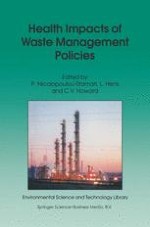2000 | OriginalPaper | Buchkapitel
Waste Management Policies in the United States of America
verfasst von : G. Valaoras
Erschienen in: Health Impacts of Waste Management Policies
Verlag: Springer Netherlands
Enthalten in: Professional Book Archive
Aktivieren Sie unsere intelligente Suche, um passende Fachinhalte oder Patente zu finden.
Wählen Sie Textabschnitte aus um mit Künstlicher Intelligenz passenden Patente zu finden. powered by
Markieren Sie Textabschnitte, um KI-gestützt weitere passende Inhalte zu finden. powered by
Waste management has become a major environmental management problem in recent years, as the quantity of waste streams increases and grows in complexity: the result of an ever-widening range of products in our consumer-based society. Hazardous waste in particular has been subject to detailed and costly regulations since the early 1980’s, when unregulated toxic wastes were associated with profound health effects in exposed populations at Love Canal, New York and Times Beach, Missouri. The legislative response in the United States has been comprehensive, yet a whole list of problems still exist which need more sophisticated management within the US regulatory framework. The United States regulates waste in terms of two broad categories, hazardous waste and municipal solid waste. The two categories together generated about 422 million tons during the year 1995–96. Solid waste is not considered hazardous, despite the fact that it contains household hazardous waste. Although household waste is, in fact, a mixture of inert and toxic components, it is regulated as municipal solid waste, without the strict federal regulations which apply to hazardous waste.Through the US Environmental Protection Agency (EPA), the federal government implements laws which deal with releases of hazardous substances that may endanger public health, welfare, or the environment. To evaluate the magnitude and hazard of such releases, the EPA has developed risk assessment procedures. Quantitative risk assessment is a methodology used to evaluate hazards, exposures, and the probability of health effects on target populations.This brief review of waste management policies in the United States describes some of the current issues in risk-based decision-making, and of risk assessment methodology developed at the EPA over the past twenty-five years. Risk assessment methodology is still evolving and is constantly being refined as scientific evidence becomes available. It recently has been expanded to deal with ecological risk, and is used to quantify risks to a wide range of health effects in humans as well as in plants and animals. Most environmental regulations in the US dealing with toxic releases are based on this methodology.
